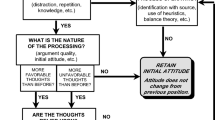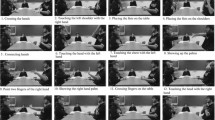Abstract
Observing nonverbal signals being directed toward unfamiliar individuals is known to influence attitudes and behavior toward those individuals. Specifically, observing biased nonverbal signals in favor of one individual over another can produce nonverbal signal-consistent attitudes among preschool children. Research has also shown that people have a tendency to mimic the behavior of others. The phenomenon of mimicking another’s nonverbal emotional response and “catching” their emotions has long been established. However, it has yet to be examined whether this phenomenon is associated with attitude contagion. We hypothesized that preschool children who mimic the biased nonverbal signals of others will be more likely to adopt their social attitudes. Results of the current study indicated that as emotional mimicry became more frequent, children showed an increasingly greater probability of acquiring nonverbal signal-consistent attitudes. Moreover, the frequency of negative—but not positive—emotional mimicry was related to an increased probability of showing nonverbal signal-consistent attitudes. Our findings provide initial support for the notion that mimicking others’ biased nonverbal signals may help facilitate attitude contagion.


Similar content being viewed by others
Notes
An additional thirteen children completed the dependent measures in a different order. Because these children responded to a different set of items after they initially watched the stimulus videos we were unable to include them in these analyses.
This was used as exclusion criteria in some of the original studies. To preserve statistical power and retain as many participants as possible, we chose to use this item as a covariate rather than exclusion criteria. See Supplemental Materials for analyses excluding children who failed the manipulation check, all statistical inferences remain the same.
References
Bandura, A., & Rosenthal, T. L. (1966). Vicarious classical conditioning as a function of arousal level. Journal of Personality and Social Psychology,3, 54–62. https://doi.org/10.1037/h0022639.
Baumeister, R. F., Bratslavsky, E., Finkenauer, C., & Vohs, K. D. (2001). Bad is stronger than good. Review of General Psychology,5, 323–370. https://doi.org/10.1037/1089-2680.5.4.323.
Blairy, S., Herrera, P., & Hess, U. (1999). Mimicry and the judgment of emotional facial expressions. Journal of Nonverbal Behavior,23, 5–41. https://doi.org/10.1023/A:1021370825283.
Bourgeois, P., & Hess, U. (2008). The impact of social context on mimicry. Biological Psychology,77, 343–352. https://doi.org/10.1016/j.biopsycho.2007.11.008.
Brey, E., & Shutts, K. (2018). Children use nonverbal cues from an adult to evaluate peers. Journal of Cognition and Development,19, 121–136. https://doi.org/10.1080/15248372.2018.1449749.
Buttelmann, D., Zmyj, N., Daum, M., & Carpenter, M. (2013). Selective imitation of in-group over out-group members in 14-month-old infants. Child Development,84, 422–428. https://doi.org/10.1111/j.1467-8624.2012.01860.x.
Castelli, L., Carraro, L., Pavan, G., Murelli, E., & Carraro, A. (2012). The power of the unsaid: The influence of nonverbal cues on implicit attitudes. Journal of Applied Social Psychology,42, 1376–1393. https://doi.org/10.1111/j.1559-1816.2012.00903.x.
Castelli, L., De Dea, C., & Nesdale, D. (2008). Learning social attitudes: Children’s sensitivity to the nonverbal behaviors of adult models during interracial interactions. Personality and Social Psychology Bulletin,34, 1504–1513. https://doi.org/10.1177/0146167208322769.
Chartrand, T. L., & Bargh, J. A. (1999). The chameleon effect: The perception-behavior link and social interaction. Journal of Personality and Social Psychology,76, 893–910. https://doi.org/10.1037//0022-3514.76.6.893.
Coles, N. A., Larsen, J. T., & Lench, H. (2017). A meta-analysis of the facial feedback hypothesis literature. https://doi.org/10.31234/osf.io/svjru.
Curran, P. J., & Hussong, A. M. (2009). Integrative data analysis: The simultaneous analysis of multiple datasets. Psychological Methods,14, 81–100. https://doi.org/10.1037/a0015914.
Davis, J. I., Senghas, A., & Ochsner, K. N. (2009). How does facial feedback modulate emotional experience? Journal of Research in Personality,43, 822–829. https://doi.org/10.1016/j.jrp.2009.06.005.
de Rosnay, M., Cooper, P. J., Tsigaras, N., & Murray, L. (2006). Transmission of social anxiety from mother to infant: An experimental study using a social referencing paradigm. Behaviour Research and Therapy,44, 1165–1175. https://doi.org/10.1016/j.brat.2005.09.003.
Dimberg, U., & Lundquist, L. O. (1990). Gender differences in facial reactions to facial expressions. Biological Psychology,30, 151–159. https://doi.org/10.1016/0301-0511(90)90024-Q.
Dovidio, J. F. (2009). Psychology. Racial bias, unspoken but heard. Science,326(5960), 1641–1642. https://doi.org/10.1126/science.1184231.
Duffy, K. A., & Chartrand, T. L. (2015). Mimicry: Causes and consequences. Current Opinion in Behavioral Sciences,3, 112–116. https://doi.org/10.1016/j.cobeha.2015.03.002.
Ekman, P., Levenson, R. W., & Friesen, W. V. (1983). Automatic nervous system activity distinguishes among emotions. Science,221, 1208–1210. https://doi.org/10.1126/science.6612338.
Fawcett, C., & Liszkowski, U. (2012). Mimicry and play initiation in 18-month-old infants. Infant Behavior and Development,35, 689–696. https://doi.org/10.1016/j.infbeh.2012.07.014.
Geangu, E., Quadrelli, E., Conte, S., Croci, E., & Turati, C. (2016). Three-year-olds’ rapid facial electromyographic responses to emotional facial expressions and body postures. Journal of Experimental Child Psychology,144, 1–14. https://doi.org/10.1016/j.jecp.2015.11.001.
Grossard, C., Chaby, L., Hun, S., Pellerin, H., Bourgeois, J., Dapogny, A., et al. (2018). Children facial expression production: Influence of age, gender, emotion subtype, elicitation condition and culture. Frontiers in Psychology,9, 446. https://doi.org/10.3389/fpsyg.2018.00446.
Hamlin, J. K., Wynn, K., & Bloom, P. (2010). 3-month-olds show a negativity bias in their social evaluations. Developmental Science,13, 923–929. https://doi.org/10.1111/j.1467-7687.2010.00951.x.
Hatfield, E., Cacioppo, J. T., & Rapson, R. L. (1992). Primitive emotional contagion. Review of Personality and Social Psychology,14, 151–177.
Hatfield, E., Cacioppo, J. T., & Rapson, R. L. (1994). Emotional contagion. Cambridge: Cambridge University Press.
Hatfield, E. C., Bensman, L., Thornton, P. D., & Rapson, R. L. (2014). New perspectives on emotional contagion: A review of classic and recent research on facial mimicry and contagion. Interpersona: An International Journal on Personal Relationships,8, 159–179. https://doi.org/10.5964/ijpr.v8i2.162.
Hawk, S. T., Fischer, A. H., & van Kleef, G. A. (2012). Face the noise: Embodied responses to nonverbal vocalizations of discrete emotions. Journal of Personality and Social Psychology,102, 796–814. https://doi.org/10.1037/a0026234.
Heider, F. (1958). The psychology of interpersonal relations. New York: Wiley.
Hess, U., & Bourgeois, P. (2010). You smile–I smile: Emotion expression in social interaction. Biological Psychology,84, 514–520. https://doi.org/10.1016/j.biopsycho.2009.11.001.
Hess, U., & Fischer, A. (2013). Emotional mimicry as social regulation. Personality and Social Psychology Review,17, 142–157. https://doi.org/10.1177/1088868312472607.
Hess, U., & Fischer, A. (2014). Emotional mimicry: Why and when we mimic emotions. Social and Personality Psychology Compass,8, 45–57. https://doi.org/10.1111/spc3.12083.
Hess, U., & Fischer, A. (2017). The role of emotional mimicry in intergroup relations. Oxford Research Encyclopedia of Communication. https://doi.org/10.1093/acrefore/9780190228613.013.433.
Ipser, A., & Cook, R. (2015). Inducing a concurrent motor load reduces categorization precision for facial expressions. Journal of Experimental Psychology: Human Perception and Performance,42, 706–718. https://doi.org/10.1037/xhp0000177.
Isomura, T., & Nakano, T. (2016). Automatic facial mimicry in response to dynamic emotional stimuli in five-month-old infants. Proceedings of the Royal Society B,283(1844), 20161948. https://doi.org/10.1098/rspb.2016.1948.
Ito, T. A., Larsen, J. T., Smith, N. K., & Cacioppo, J. T. (1998). Negative information weighs more heavily on the brain: The negativity bias in evaluative categorizations. Journal of Personality and Social Psychology,75, 887–900. https://doi.org/10.1037/0022-3514.75.4.887.
Kavanagh, L. C., & Winkielman, P. (2016). The functionality of spontaneous mimicry and its influences on affiliation: An implicit socialization account. Frontiers in Psychology,7, 458. https://doi.org/10.3389/fpsyg.2016.00458.
Kulesza, W. M., Cisłak, A., Vallacher, R. R., Nowak, A., Czekiel, M., & Bedynska, S. (2015). The face of the chameleon: The experience of facial mimicry for the mimicker and the mimickee. The Journal of Social Psychology,155, 590–604.
Laird, J. D. (1984). The real role of facial response in the experience of emotion: A reply to Tourangeau and Ellsworth, and others. Journal of Personality and Social Psychology,47, 909–917. https://doi.org/10.1037/0022-3514.47.4.909.
Lakin, J. L., & Chartrand, T. L. (2003). Using nonconscious behavioral mimicry to create affiliation and rapport. Psychological Science,14, 334–339. https://doi.org/10.1023/A:1025389814290.
Lakin, J. L., Chartrand, T. L., & Arkin, R. M. (2008). I am too just like you: Nonconscious mimicry as an automatic behavioral response to social exclusion. Psychological Science,19, 816–822. https://doi.org/10.1111/j.1467-9280.2008.02162.x.
Lakin, J. L., Jefferis, V. E., Cheng, C. M., & Chartrand, T. L. (2003). The chameleon effect as a social glue: Evidence for the evolutionary significance of nonconscious mimicry. Journal of Nonverbal Behavior,27, 145–162. https://doi.org/10.1023/A:1025389814290.
Lawrence, K., Campbell, R., & Skuse, D. (2015). Age, gender, and puberty influence the development of facial emotion recognition. Frontiers in Psychology,6, 1–14. https://doi.org/10.3389/fpsyg.2015.00761.
Lehane, C. M. (2015). Male and female differences in nonconscious mimicry: A systematic review. Journal of European Psychology Students,6(3), 34–48. https://doi.org/10.5334/jeps/de.
Maringer, M., Krumhuber, E. G., Fischer, A. H., & Niedenthal, P. M. (2011). Beyond smile dynamics: Mimicry and beliefs in judgments of smiles. Emotion,11, 181–187. https://doi.org/10.1037/a0022596.
McShane, B. B., & Böckenholt, U. (2017). Single paper meta-analysis: Benefits for study summary, theory-testing, and replicability. Journal of Consumer Research,43, 1048–1063. https://doi.org/10.1093/jcr/ucw085.
Meltzoff, A. N., & Moore, M. K. (1977). Imitation of facial and manual gestures by human neonates. Science,198(4312), 75–78. https://doi.org/10.1126/science.198.4312.75.
Meltzoff, A. N., & Moore, M. K. (1994). Imitation, memory, and the representation of persons. Infant Behavior and Development,17, 83–99. https://doi.org/10.1016/0163-6383(94)90024-8.
Moody, E. J., Reed, C. L., Van Bommel, T., App, B., & McIntosh, D. N. (2018). Emotional mimicry beyond the face? Rapid face and body responses to facial expressions. Social Psychological and Personality Science,9, 844–852. https://doi.org/10.1177/1948550617726832.
Murata, A., Saito, H., Schug, J., Ogawa, K., & Kameda, T. (2016). Spontaneous facial mimicry is enhanced by the goal of inferring emotional states: Evidence for moderation of “automatic” mimicry. Higher Cognitive Processes,11(4), 1–15. https://doi.org/10.1371/journal.pone.0153128.
Neal, D. T., & Chartrand, T. L. (2011). Embodied emotion perception: Amplifying and dampening facial feedback modulates emotion perception accuracy. Social Psychological and Personality Science,2, 673–678. https://doi.org/10.1177/1948550611406138.
Nielsen, M., & Blank, C. (2011). Imitation in young children: When who gets copied is more important than what gets copied. Developmental Psychology,47, 1050–1053. https://doi.org/10.1037/a0023866.
Oberman, L. M., Winkielman, P., & Ramachandran, W. S. (2007). Face to face: Blocking facial mimicry can selectively impair recognition of emotional expressions. Social Neuroscience,2(3–4), 167–178. https://doi.org/10.1080/17470910701391943.
Rozin, P., & Royzman, E. B. (2001). Negativity bias, negativity dominance, and contagion. Personality and Social Psychology Review,5, 296–320. https://doi.org/10.1207/S15327957PSPR0504_2.
Rychlowska, M., Cañadas, E., Wood, A., Krumhuber, E. G., Fischer, A., & Niedenthal, P. M. (2014). Blocking mimicry makes true and false smiles look the same. PLoS ONE,9(3), E90876. https://doi.org/10.1371/journal.pone.0090876.
Rymarczyk, K., Żurawski, Ł., Jankowiak-Siuda, K., & Szatkowska, I. (2016a). Do dynamic compared to static facial expressions of happiness and anger reveal enhanced facial mimicry? PLoS ONE,11(7), e0158534. https://doi.org/10.1371/journal.pone.0158534.
Rymarczyk, K., Żurawski, Ł., Jankowiak-Siuda, K., & Szatkowska, I. (2016b). Emotional empathy and facial mimicry for static and dynamic facial expressions of fear and disgust. Frontiers in Psychology,7, 1853. https://doi.org/10.3389/fpsyg.2016.01853.
Skinner, A. L., Meltzoff, A. N., & Olson, K. R. (2017). “Catching” social bias: Exposure to biased nonverbal signals creates social biases in preschool children. Psychological Science,28, 216–224. https://doi.org/10.1177/0956797616678930.
Skinner, A. L., Olson, K. R., & Meltzoff, A. N. (2019). Acquiring group bias: Observing other people’s nonverbal signals can create social group biases. Journal of Personality and Social Psychology. https://doi.org/10.1037/pspi0000218.
Sonnby-Borgstrom, M., Jonsson, P., & Svensson, O. (2003). Emotional empathy as related to mimicry reactions at different levels of information processing. Journal of Nonverbal Behavior,27, 3–23. https://doi.org/10.1023/A:1023608506243.
Stel, M., & Vonk, R. (2010). Mimicry in social interaction: Benefits for mimickers, mimickees, and their interaction. British Journal of Psychology,101, 311–323. https://doi.org/10.1348/000712609X465424.
Tschacher, W., Rees, G. M., & Ramseyer, F. (2014). Nonverbal synchrony and affect in dyadic interactions. Frontiers in Psychology,5, 1323.
Vaish, A., Grossmann, T., & Woodward, A. (2008). Not all emotions are created equal: The negativity bias in social-emotional development. Psychological Bulletin,134, 383–403. https://doi.org/10.1037/0033-2909.134.3.383.
van Schaik, J. E., & Hunnius, S. (2016). Little chameleons: The development of social mimicry during early childhood. Journal of Experimental Child Psychology,147, 71–81. https://doi.org/10.1016/j.jecp.2016.03.003.
Weisbuch, M., Pauker, K., & Ambady, N. (2009). The subtle transmission of race bias via televised nonverbal behavior. Science,326, 1711–1714. https://doi.org/10.1126/science.1178358.
Widen, S. C. (2013). Children’s interpretation of facial expressions: The long path from valence-based to specific discrete categories. Emotion Review,5, 72–77. https://doi.org/10.1177/1754073912451492.
Willard, G., Issac, K., & Carney, D. R. (2015). Some evidence for the nonverbal contagion of racial bias. Organizational Behavior and Human Decision Processes,128, 96–107. https://doi.org/10.1016/j.obhdp.2015.04.002.
Yabar, Y., Johnston, L., Miles, L., & Peace, V. (2006). Implicit behavioral mimicry: Investigating the impact of group membership. Journal of Nonverbal Behavior,30, 97–113. https://doi.org/10.1007/s10919-006-0010-6.
Author information
Authors and Affiliations
Corresponding author
Additional information
Publisher's Note
Springer Nature remains neutral with regard to jurisdictional claims in published maps and institutional affiliations.
Electronic supplementary material
Below is the link to the electronic supplementary material.
Rights and permissions
About this article
Cite this article
Skinner, A.L., Osnaya, A., Patel, B. et al. Mimicking Others’ Nonverbal Signals is Associated with Increased Attitude Contagion. J Nonverbal Behav 44, 117–131 (2020). https://doi.org/10.1007/s10919-019-00322-1
Published:
Issue Date:
DOI: https://doi.org/10.1007/s10919-019-00322-1




